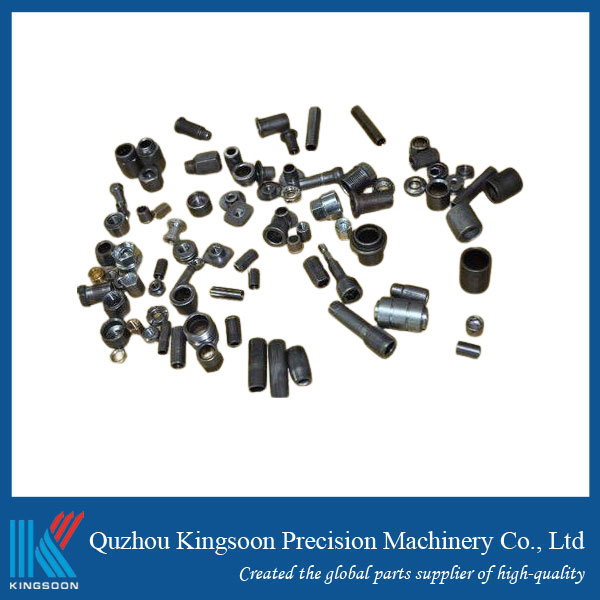What Makes Forging Parts the Backbone of Modern Manufacturing?
2025-11-12
Forging parts refer to metal components that are shaped by applying compressive forces through forging processes such as hot forging, cold forging, or precision die forging. These methods alter the metal’s internal structure, resulting in components with exceptional strength, durability, and resistance to fatigue. Forging is widely used in automotive, aerospace, construction, agricultural machinery, and energy industries.
In modern manufacturing, forging parts play a vital role because they ensure mechanical reliability under extreme stress and temperature conditions. Unlike cast or machined components, forged parts possess refined grain structures that enhance performance and longevity. This makes them ideal for critical applications such as engine crankshafts, connecting rods, gears, flanges, shafts, and bearing housings.
The center of this discussion lies in understanding how forging technology supports global industrial progress. The continuous evolution of forging techniques—combining precision machinery, automated control, and sustainable material practices—drives efficiency, consistency, and environmental responsibility.
Below are the typical product parameters that define the quality and application scope of forging parts:
| Parameter | Description |
|---|---|
| Material | Carbon steel, alloy steel, stainless steel, brass, aluminum |
| Forging Type | Open die forging, closed die forging, hot forging, cold forging |
| Tolerance Level | ±0.01–0.05 mm (depending on size and complexity) |
| Surface Finish | Sandblasted, polished, heat-treated, coated |
| Heat Treatment | Normalizing, quenching, tempering, annealing |
| Application Industries | Automotive, machinery, construction, aerospace, oil & gas |
| Production Capacity | 500 tons/month |
| Inspection Methods | Ultrasonic testing, hardness testing, dimensional analysis |
| Customization Options | Material selection, precision machining, surface coating, logo engraving |
Forging parts represent the balance between structural integrity and manufacturing precision. As industries demand stronger and lighter components, forging has proven itself to be a technology that continuously adapts to engineering challenges.
Why Are Forging Parts Superior Compared to Casting or Machining?
The superiority of forging parts comes from the metallurgical advantages and mechanical consistency achieved during the forging process. When metal is forged, the grains are aligned to follow the shape of the part, creating a continuous flow of the material structure. This flow enhances fatigue resistance, tensile strength, and impact toughness.
Key Advantages of Forging Parts:
-
Higher Strength and Reliability – Forging compresses and refines the internal structure, eliminating voids and porosity that often occur in cast components. This results in superior mechanical performance.
-
Better Structural Integrity – Grain flow alignment minimizes weak points, allowing forged parts to handle higher loads and cyclic stresses.
-
Enhanced Dimensional Accuracy – Advanced die forging and CNC finishing provide consistent shapes with minimal post-machining.
-
Longer Service Life – The high durability of forged metals ensures reduced maintenance costs and downtime in heavy-duty equipment.
-
Material Efficiency – Forging produces less waste compared to machining processes, making it cost-effective and environmentally sustainable.
Additionally, forged components exhibit better wear resistance and are capable of functioning in harsh environments, such as oil drilling rigs or high-speed engines.
Example:
A forged crankshaft, due to its superior fiber alignment and strength, performs better under high rotational stresses compared to a cast or welded version. It offers smoother operation, better balance, and extended engine life.
Therefore, the question “why forging parts?” is best answered through their proven reliability across critical sectors that demand both performance and safety. Forging does not merely shape metal; it shapes industrial progress.
How Are Forging Parts Produced and What Technologies Drive Their Evolution?
The production of forging parts involves a series of precise and controlled processes. The key stages include material preparation, heating, forming, trimming, heat treatment, machining, surface finishing, and quality inspection.
Step-by-Step Process of Forging Parts Manufacturing:
-
Material Selection – Choosing the right alloy based on strength, temperature resistance, and application requirements.
-
Heating – Metal billets are heated to optimal forging temperatures (ranging from 950°C to 1250°C for steel) to improve malleability.
-
Forging – Mechanical or hydraulic presses apply pressure to form the metal into desired shapes.
-
Trimming and Flash Removal – Excess metal is trimmed to achieve precision geometry.
-
Heat Treatment – Processes like quenching and tempering improve hardness and toughness.
-
Machining and Surface Finishing – CNC machining and polishing achieve final tolerances and aesthetics.
-
Inspection and Testing – Non-destructive testing (NDT) ensures structural integrity and dimensional accuracy.
Modern Technologies Driving Forging Evolution:
-
Precision CNC Integration: Combining forging with high-precision CNC machining enhances dimensional control and reduces defects.
-
Automation and Robotics: Automated forging lines improve consistency, safety, and productivity.
-
Simulation Software: Computer-aided die design and flow simulation optimize material deformation and minimize waste.
-
Eco-Friendly Heat Management: Advanced furnaces and induction heating reduce energy consumption and emissions.
These innovations demonstrate how traditional forging is merging with smart manufacturing principles. The result is not only superior quality but also sustainability—ensuring that forging remains a cornerstone of modern industry.
Future Trends in Forging Technology:
-
Adoption of AI-based process monitoring (note: this refers to industrial automation systems, not content generation).
-
Development of lightweight forged aluminum and titanium components for electric vehicles.
-
Integration of green forging practices with recycled alloys and energy-efficient furnaces.
-
Expansion of precision micro-forging for electronics and medical components.
The future of forging parts will focus on precision, performance, and sustainability—key elements that define the next generation of industrial innovation.
What Are the Key Market Trends and Common Questions About Forging Parts?
As global industries move toward higher standards of safety and performance, the demand for forged components continues to expand. Automotive manufacturers seek lighter and stronger parts to enhance fuel efficiency. Aerospace companies depend on precision-forged components for reliability under extreme conditions. Infrastructure and machinery sectors value forged steel for its toughness and durability.
Market Trends Shaping the Forging Industry:
-
Sustainable Manufacturing: Use of energy-efficient processes and recyclable materials.
-
Customization and Flexibility: OEMs require customized designs with quick turnaround times.
-
Digitalization of Production: Smart factories and digital twins optimize output and quality control.
-
Rising Demand in EV and Renewable Energy Sectors: Lightweight yet durable forged parts support these emerging markets.
-
Global Supply Chain Resilience: Localized forging capacities reduce dependency and logistics costs.
Together, these trends emphasize that forging will remain indispensable to future industrial ecosystems.
Common FAQs About Forging Parts
Q1: What factors should be considered when choosing materials for forging parts?
A1: Material selection depends on the intended application, strength requirements, temperature exposure, and corrosion resistance. Carbon steel and alloy steel are widely used for strength and durability, while stainless steel is preferred for corrosion resistance. Aluminum and brass are suitable for lightweight or decorative applications. The correct combination of alloy composition and heat treatment ensures the final product meets performance expectations.
Q2: How do forged parts contribute to cost efficiency in manufacturing?
A2: Forged parts reduce long-term costs due to their durability and minimal maintenance needs. The production process also minimizes material waste compared to machining from solid blocks. Additionally, the superior mechanical properties reduce the risk of component failure, saving downtime and replacement expenses in industrial operations.
The Future of Forging Parts and Industry Leadership
Forging parts are not just industrial components—they are the foundation of modern engineering reliability. Their unmatched strength, structural integrity, and adaptability make them essential for applications ranging from automotive engines to high-speed turbines and heavy machinery.
The continuous advancement in forging techniques, combined with automation and sustainable practices, ensures that these components will remain critical to the evolution of global manufacturing. Precision, durability, and innovation define the forging industry’s next chapter.
Quzhou Kingsoon Precision Machinery Co., Ltd. stands at the forefront of this development, delivering high-quality forging parts tailored to diverse industrial needs. With years of technical expertise, strict quality control, and advanced production facilities, the company is dedicated to offering durable, cost-effective, and custom-engineered forging solutions for clients worldwide.
For more details about product specifications, customization options, and partnership opportunities, Contact Us today to learn how Quzhou Kingsoon Precision Machinery Co., Ltd. can support your next project with precision-forged excellence.



